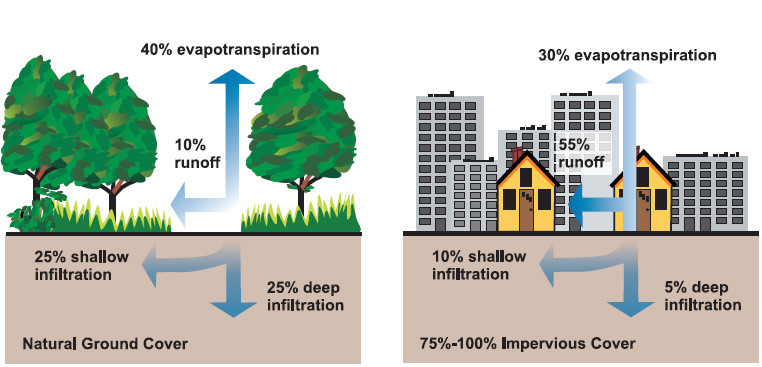Introduction to Rain Gardens: Harnessing Nature's Gift for Sustainability

Rain gardens can turn rain into beauty in our garden, which is something we specialize in! Rain gardens are not only an attractive element in our landscape; but also a sustainable resource in our endeavor to conserve water. In this blog, we'll explore the concept of rain gardens. By transforming rainwater into a resource, rain gardens offer a unique blend of functionality and aesthetics. The photo above shows a rain garden that Water Efficient Gardens designed - the one in the middle with purple flowers.
What Is A Rain Garden?
A rain garden is a shallow depression in the
landscape that is connected to a down spout and collects rainwater from impervious surfaces, such as roofs,
allowing it to infiltrate into the ground. Unlike a traditional garden, a rain
garden is specifically situated to capture water from heavy rain events.
A rain garden can serve some very important functions. They excel in flooding prevention, pollutant filtration, and groundwater recharge.
1. Reduce runoff and the threat of flash flood
This is one of the most important functions of a rain garden. In nature, only 10% rainwater runs off, but in an urban environment, with the prevalent presence of impervious surfaces, such as roofs, streets, etc., more than half of the water (55%) does. In nature, half of the rainfall will go back to the soil, with half of that soaking deeply down. In a city, only 15% will get back to the soil, and only a tiny portion (5%) infiltrates deeply.
With the heavy runoff, the threat of a flash flood increases. Rain gardens, on the other hand, can effectively divert rainwater back to the soil, reduce runoff volume in the cities. reduce the threat of erosion and flash flood.

2. Filter out pollutants
When the rain water flows over the streets, it will collect all kinds of pollutants such as machine oil, pesticides, harmful chemicals, and flows down the storm drain into the waterways, harming the wildlife there. In a rain garden, the pollutants will be filtered out before it goes back to the underground water, eliminating the risk to the marine life.
3. Recharge groundwater
Aquafers are a critical resource of water, however, with the ever-increasing need for water, many of them have been seriously depleted, for some it might even take up to several hundred years to recover. To recharge ground water is something really important, which the rain gardens can effectively deliver.
4. Grow a habitat for wildlife
Plants for a rain garden need to stand both conditions well: wet soil when it rains, and dry soil when it is hot in summer. Most of the plants used for a rain garden are native plants. They are adapted to the local weather and can adjust well to the local rainfall patterns. Native plants can provide a habitat for the bees, birds and butterflies, increasing biodiversity.
These gardens are effective not just in residential settings but also in commercial sites and public spaces, offering a cost-effective solution for environmental protection and ecosystem benefits.
The true beauty of a rain garden lies in its
dual functionality: it serves as a critical component in managing stormwater
sustainably while enhancing the aesthetics of the landscape with vibrant native
plants, flowers, and grasses. The selection of these plants is strategic; they
are chosen for their ability to thrive in the wet conditions of a rain garden
and to withstand the dry periods between rainfalls. This resilience makes rain
gardens a cornerstone of ecological landscaping, offering a habitat for pollinators
and birds, promoting biodiversity, and restoring natural water cycles disturbed
by urban development.
Size of the Rain Garden - How Would
You Decide?
Determining the size of a rain garden is a
crucial step that depends on several factors, including the size of the
drainage area (the area that contributes runoff to the garden), the soil type,
and the amount of rainfall your region typically receives. The goal is to
create a garden that can handle the average rain event without overflowing,
while also allowing the water to infiltrate the ground within 24 to 48 hours to
prevent mosquito breeding.
Here's a simplified approach to deciding the size of your rain garden:
Assess the Drainage Area: Measure the square footage of the area (e.g., a section of your roof) that will drain into the rain garden. This calculation helps estimate the volume of water your garden will need to manage during a rain event.
Understand Your Soil Type: The infiltration rate of your soil—sandy, loam, or clay—significantly impacts the size of your rain garden. Sandy soils drain faster and require a smaller garden, while clay soils, which drain slowly, necessitate a larger area to allow enough time for water absorption.
Rainfall Consideration: Consider the average rainfall in your area. In regions with heavy rainfall, you may need to increase the size of your rain garden to accommodate the increased volume of water.
Design
for Capacity: Plan for your garden to hold about 6
inches of water before it overflows. This depth is typically sufficient to
handle most rain events and allows for adequate water infiltration.
By thoughtfully determining the size of your rain garden, you ensure its effectiveness in capturing and filtering rainwater, thereby reducing runoff and contributing to groundwater recharge. Consultation with a professional can provide personalized advice, taking into account the unique aspects of your landscape and climate.
Designing Your Rain Garden
Creating a rain garden starts with understanding your landscape. Location is key – ideally, a rain garden is situated near downspouts or runoff sources but away from building foundations. The size and depth are determined by the area's rainfall patterns and soil type. Preparing the soil with organic matter can enhance its water-absorbing capacity, making your garden both resilient and robust. For those looking to integrate rain gardens into their landscapes, Water Efficient Gardens offers expert services. We specialize in designing and creating rain gardens that are tailored to individual landscapes and environmental conditions.
Plant Selection: The Heart of Your
Rain Garden
Plant selection is the cornerstone of a thriving rain garden. At Water Efficient Gardens, we emphasize choosing plants that are not only native and drought-resistant but also in harmony with the local ecosystem. Native plants have evolved to flourish in specific regional climates, making them ideal candidates for rain gardens. They are adept at managing water efficiently and supporting local biodiversity. Additionally, these plants typically require less maintenance and are more resistant to local pests and diseases.
Deep-rooted species are particularly effective in rain gardens. Their roots penetrate deep into the soil, aiding in the absorption and filtration of rainwater, a crucial process for recharging groundwater and preventing runoff. These roots also help to stabilize the soil structure, preventing erosion and supporting the garden's infrastructure.
Layering different types of plants, including a mix of grasses, perennials, shrubs, and even small trees, contributes to creating a diverse and resilient ecological space. This diversity is not only visually striking but also creates a mini-ecosystem that supports various wildlife species. Flowering plants can attract pollinators like bees and butterflies, while shrubs and grasses provide habitat for birds and small mammals.
In designing rain gardens, Water Efficient Gardens focuses on plant compositions that are both aesthetic and functional. By carefully selecting plants based on their water needs, growth habits, and the visual appeal, we create rain gardens that are a mosaic of colors, textures, and forms. Each plant plays a role in this living tapestry, contributing to the garden's overall health and the beauty of your outdoor space.
The selection of the right plants is a process that blends art and science, requiring knowledge of horticulture, local climates, and garden design principles. It's a process where environmental stewardship meets aesthetic vision, resulting in gardens that are not only a delight to the senses but also a testament to sustainable practices.
Installation and Maintenance
The installation of a rain garden is a journey that begins with thoughtful planning and ends with the satisfaction of contributing positively to the environment. The first step is to carefully choose the location, ensuring it's ideally positioned to collect runoff while being safe from overflowing during heavy rains. The process involves excavating the site to the appropriate depth, which varies depending on soil type and garden size. Proper grading is essential to direct water flow into the garden without causing pooling or erosion.
Next, the incorporation of a suitable soil mix that encourages water infiltration while providing enough support for plants is vital. In some cases, amending the existing soil with compost or sand improves its texture and fertility, enhancing the garden's overall health.
Once the groundwork is laid, the fun part of planting begins. Arranging plants according to their water needs and aesthetic value brings the design to life. It's important to give plants enough space to grow and thrive, considering their mature sizes.
Regular maintenance is key to the garden's longevity and effectiveness. This includes seasonal tasks like clearing debris, pruning, and dividing plants as they grow. Mulching plays a crucial role in retaining soil moisture and suppressing weeds, thereby reducing the garden's water needs and upkeep.
Water Efficient Gardens emphasizes the importance of a maintenance routine that aligns with nature's cycles. This involves observing the garden's natural changes and adapting care accordingly. For instance, less watering is needed as plants establish themselves and the garden's ecosystem becomes more self-sustaining.
Monitoring the garden, especially after rain events, helps identify any issues with drainage or plant health. Quick interventions can prevent problems from escalating, ensuring the rain garden remains a functional and beautiful part of your landscape.
In summary, while the initial setup of a rain garden requires effort and attention to detail, the ongoing care is relatively minimal yet impactful. With each season, the garden evolves, becoming a testament to sustainable landscaping and an inspiration for eco-conscious living.
Inspiring Others Through Shared Experiences
Elizabeth's willingness to share her garden's development and the remarkable outcomes invites others to consider how they, too, can contribute to water conservation and biodiversity enhancement. Her story, featured in our blog, serves as an inspiration, showcasing the tangible benefits and rewarding experiences that come with creating a rain garden. From reducing water usage to fostering a haven for wildlife, Elizabeth's journey exemplifies the profound impact of integrating sustainable practices into our landscapes.
Elizabeth's story enriches our understanding of rain gardens, not just as environmental tools, but as catalysts for personal and community growth. Her experience underscores the importance of pursuing sustainability with passion and curiosity, reminding us that the journey toward a greener future is as rewarding as the destination. As we continue to champion the creation of rain gardens, let us draw inspiration from Elizabeth and the countless others who have embraced this sustainable path. Together, we can transform our landscapes into vibrant, eco-friendly spaces that celebrate the beauty of nature and the resilience of our communities
Conclusion
In conclusion, the creation of a rain garden, as championed by Water Efficient Gardens, is more than just a landscaping endeavor; it's a meaningful step towards environmental stewardship. By integrating a rain garden into your landscape, you're not only enhancing the beauty of your property but also contributing to a larger movement of water conservation and ecological balance. Rain gardens embody the principles of sustainable living, offering a practical solution to urban water runoff while creating a haven for local wildlife and native flora. They remind us that each individual effort, no matter how small, can collectively make a significant impact on our planet's health. Embrace the journey of creating your rain garden and witness how a simple act can ripple into lasting environmental benefits.
